With about 400 outlets in Taiwan, China and Singapore, Wowprime (王品) is one of the nation’s largest restaurant chain operators. Inspired by yakiniku (traditional Japanese barbecue), the group established the YakiYan Japanese BBQ Restaurant chain in 2004, which specializes in Japanese-style barbecue with light seasoning and sauce. Operating 26 outlets across Taiwan, it plans to open a branch next year in California.
My colleagues and I recently made dinner reservations for 12 people on a weekday at the restaurant’s flagship branch on Nanjing E Rd, a roughly 10-minute walk from the Zhongshan MRT Station (中山站). We were quickly seated at two tables in a private room on the second floor of the two-story restaurant, each table was equipped with a barbecue grill in the middle. The room’s walls were finished elegantly with stone slate, lending it a modern Japanese atmosphere, while the soothing sounds of jazz and the sound of running water added a relaxing touch. A polite and efficient waiter placed my backpack in a basket, so that it wouldn’t smell of barbecue.
YakiYan offers a la carte and seven-dish sets (NT$628). Each set comes with salad, soup, lettuce to wrap the meat in, a main course, rice, a drink and dessert. There are three to five options for each dish.
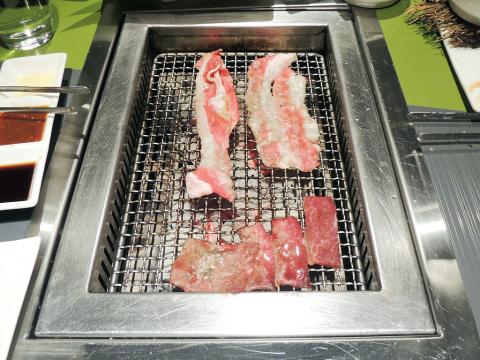
Photo: Eddy Chang, Taipei Times
I was disappointed with the rice paper spring roll with Italian sauce, which was flavorless. The fruit with yoghurt and cherry duck and apple salad ordered by my collegues, however, were fresh and appetizing.
The mixed mushroom soup was served next. I highly recommend the creamy soup with chopped shiitake mushrooms, which have a strong truffle-like aroma. After serving us the lettuce, the waiters and waitresses then started to put coals under the grill.
There were five options for the main course: assorted beef (原燒牛肉拼盤), assorted pork (原燒豬肉拼盤), a beef and pork combo (原燒牛豬拼盤), a beef and poultry combo (牛肉綜合拼盤) and a pork and poultry combo (豬肉綜合拼盤). I chose the beef combo, which features several cuts of beef and is served with slices of corn, onion and pumpkin along with three dipping sauces. French sea salt and seven-spice powder were also available on each table. I lightly grilled the boneless short rib steak and other beef items for just a few minutes, and they all tasted tender and juicy.
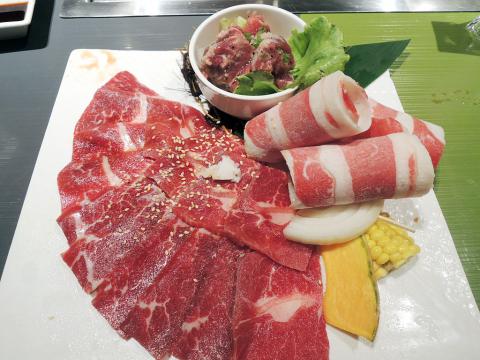
Photo: Eddy Chang, Taipei Times
The grilled foods tasted even better with the sweet and salty miso sauce, but the soy or lemon sauce did not complement the beef at all. Some of my colleagues recommend the two combos with poultry, because each dish includes sliced chicken leg and cherry duck, which are good options if you don’t like red meat. Or you could always order the vegetarian set (NT$628). I tried a colleague’s veggie set and liked the grilled water bamboo shoots, which had a natural sweetness.
The rice was served as we were grilling the ingredients. I had the dolsot bibimbap, which is mixed rice and vegetables in a hot stone cookware. Finally, I had the frosted black tea and Japanese banana dumplings, which were a big disappointment. Despite the colorful presentation, they were not as crispy as they should be, and were far too greasy. The red bean soup and YakiYan ice cream are much better choices, as I’d realized on previous visits.
For dinner, each of the nine adults paid NT$691 including 10 percent service charge. The three children in our party received a free meal because they were under 12. It included a rice ball, bread, soup and a drink. We also received two coffee cups as gifts, and vouchers of two free dishes for our next visit. Overall, YakiYan was a pleasing dining experience, but there is room for improvement on the dessert.
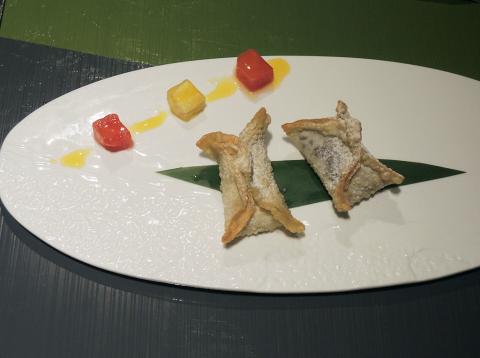
Photo: Eddy Chang, Taipei Times
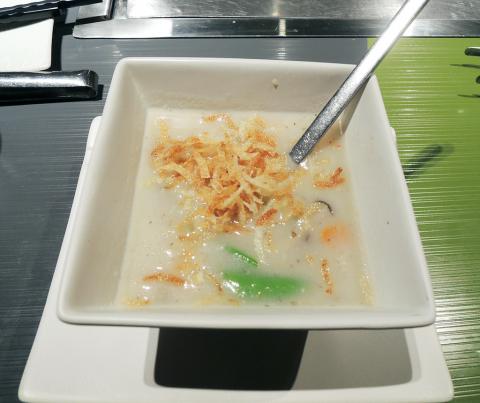
Photo: Eddy Chang, Taipei Times
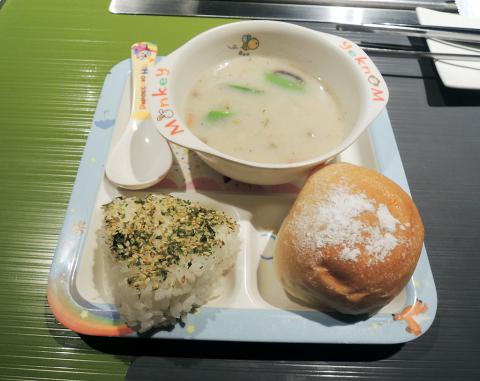
Photo: Eddy Chang, Taipei Times

Oct. 27 to Nov. 2 Over a breakfast of soymilk and fried dough costing less than NT$400, seven officials and engineers agreed on a NT$400 million plan — unaware that it would mark the beginning of Taiwan’s semiconductor empire. It was a cold February morning in 1974. Gathered at the unassuming shop were Economics minister Sun Yun-hsuan (孫運璿), director-general of Transportation and Communications Kao Yu-shu (高玉樹), Industrial Technology Research Institute (ITRI) president Wang Chao-chen (王兆振), Telecommunications Laboratories director Kang Pao-huang (康寶煌), Executive Yuan secretary-general Fei Hua (費驊), director-general of Telecommunications Fang Hsien-chi (方賢齊) and Radio Corporation of America (RCA) Laboratories director Pan
The consensus on the Chinese Nationalist Party (KMT) chair race is that Cheng Li-wun (鄭麗文) ran a populist, ideological back-to-basics campaign and soundly defeated former Taipei mayor Hau Lung-bin (郝龍斌), the candidate backed by the big institutional players. Cheng tapped into a wave of popular enthusiasm within the KMT, while the institutional players’ get-out-the-vote abilities fell flat, suggesting their power has weakened significantly. Yet, a closer look at the race paints a more complicated picture, raising questions about some analysts’ conclusions, including my own. TURNOUT Here is a surprising statistic: Turnout was 130,678, or 39.46 percent of the 331,145 eligible party

The classic warmth of a good old-fashioned izakaya beckons you in, all cozy nooks and dark wood finishes, as tables order a third round and waiters sling tapas-sized bites and assorted — sometimes unidentifiable — skewered meats. But there’s a romantic hush about this Ximending (西門町) hotspot, with cocktails savored, plating elegant and never rushed and daters and diners lit by candlelight and chandelier. Each chair is mismatched and the assorted tables appear to be the fanciest picks from a nearby flea market. A naked sewing mannequin stands in a dimly lit corner, adorned with antique mirrors and draped foliage

The election of Cheng Li-wun (鄭麗文) as chair of the Chinese Nationalist Party (KMT) marked a triumphant return of pride in the “Chinese” in the party name. Cheng wants Taiwanese to be proud to call themselves Chinese again. The unambiguous winner was a return to the KMT ideology that formed in the early 2000s under then chairman Lien Chan (連戰) and president Ma Ying-jeou (馬英九) put into practice as far as he could, until ultimately thwarted by hundreds of thousands of protestors thronging the streets in what became known as the Sunflower movement in 2014. Cheng is an unambiguous Chinese ethnonationalist,